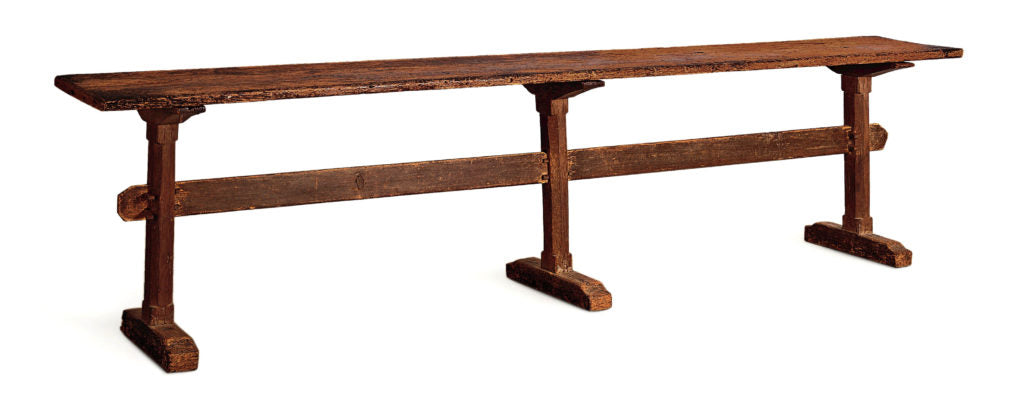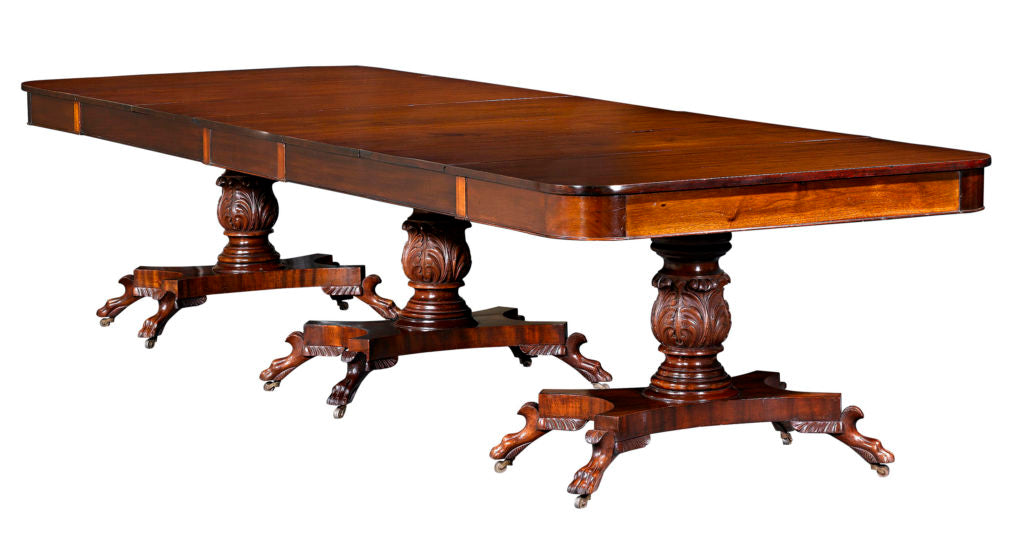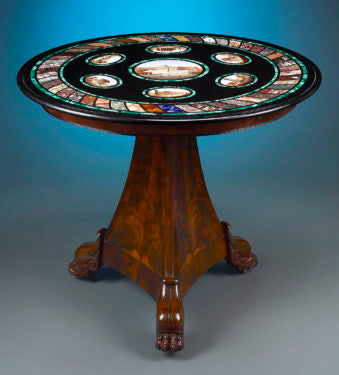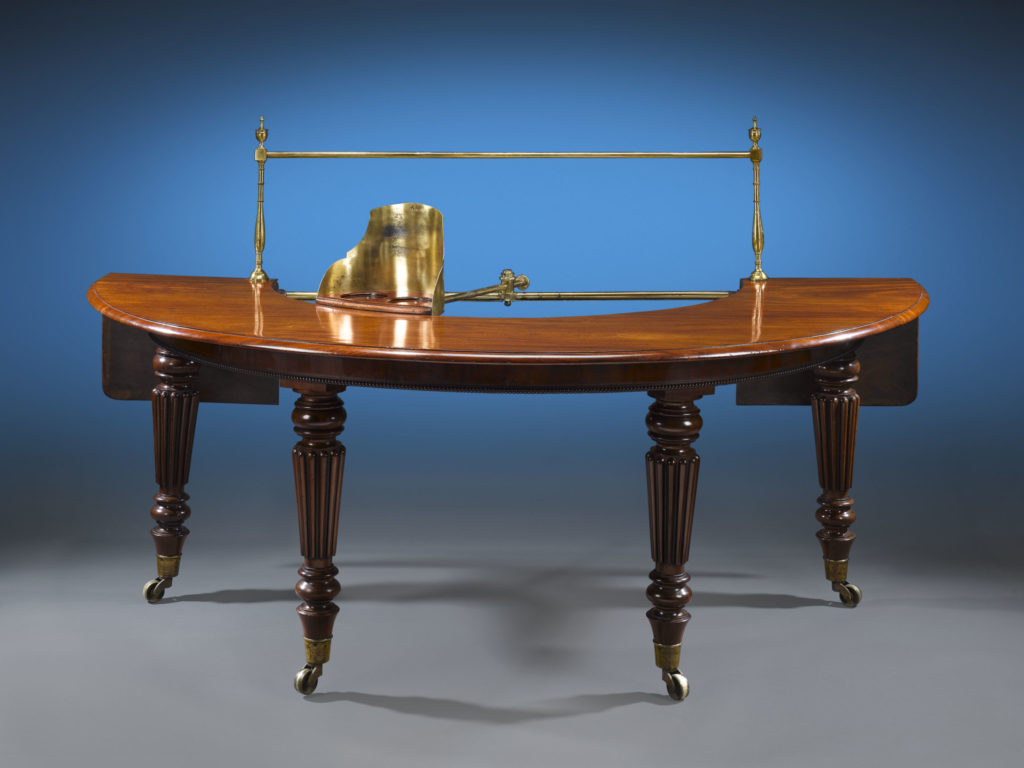
The extendable English dining table dates to the mid-17th century when tastes moved away from large, static furnishings to lighter, more accommodating styles. Walnut and oak were replaced with mahogany as the wood of choice due to its dramatic, deep red hue.
Tables are likely one of the most under-appreciated types of furniture in our homes, yet they provide the foundation for much of our home decor. From side tables displaying your cherished photos and collectibles to occasional tables providing the backdrop for family meals and celebrations, the table has a unique history and evolution from simple wood planks to the multitude of styles and forms available today. If you are hoping to learn more about antique wood tables and more, read on.
History of the Table
Have you ever wondered if your sofa table or coffee table has special origins? This guide on how to identify antique tables might just tell you if you're housing an antique piece of rare furniture. The most basic of furnishings, the table has been in use for thousands of years, though not just for dining. The ancient Egyptians crafted simple 4-legged tables of stone and wood, while the Greeks and Romans utilized more exotic materials such as bronze and cedar to craft tables that often resembled altars with slab sides for support. Later Roman examples were more decorative and often featured elaborate legs in the shape of animals, sphinxes, and other grotesque figures and were crafted lower to the ground to accommodate dining from couches.
Western dining tables, most notably those of the Medieval period, were simple planks that rested upon trestles using peg construction, which allowed them to be easily assembled and disassembled as needed. Known as "refectory tables," these trestle-based tables originated in monasteries and were later adopted for use in the Great Halls of feudal castles.
Massive rectangular antique wood tables made of oak and elm took center stage at large gatherings, but they proved to be cumbersome and difficult to move after the feasts had concluded. This was problematic as most halls were used for other purposes in addition to dining. It would be some time before the idea of a dedicated room for dining took hold.
In the 16th century, the invention of the “draw top” or “joined” table allowed you to double the length of your table with leaves that rested beneath the table top and could be extended on runners from beneath other leaves. Such tables proved to be more compact and versatile in the world of furniture design and were the first iterations of mechanical and specialized tables that were to follow over the next several hundred years.
It was also during this time that tables began to better reflect, and often define, the styles of the period, typically through the design and number of legs that supported the table. For example, the large bulbous legs of the 16th-century table are one of the most recognizable design elements of the Tudor period and can be found on most antique tables of that time.
Guide to Antique Table Types
It was around this time that we saw the development of many other types of antique tables, crafted to serve more specific purposes. From pier tables to hall tables, drafting tables to billiard tables, the various types of tables seem endless. Below is a quick guide on how to identify antique tables, table types, and some of the terminology used when referring to vintage table design. You will note that many of these terms can be used to describe a single table. For example, a tilt-top table may also feature a pie crust edge and a pedestal base.
Trestle Tables

This early, American trestle table is crafted of yellow pine and oak. Circa 1640-90. From The Met collection.
The predominant table of the Middle Ages, the trestle table is characterized by a tabletop that sits upon a trestle, a framework consisting of a horizontal stretcher or beam supported by pairs of sloping and crossed, or central legs that are inset from the edge of the table. Trestle tables allowed for maximum seating without the hindrance of table legs placed at four corners. In the early days of the trestle table, this was important as diners were often only seated on one side of the table while food and drink were served from the other side. These early tables were of peg construction and could be easily disassembled, which was important because most early castles did not have rooms dedicated to dining. The trestle table's sensible design remains popular even today.
Gate Leg Tables

This English gate-leg table is a superb example of this classic table form. Circa 1670-90. From The Met collection
The gate leg table was first used in England in the late 1600s as dining habits began to change. More intimate dining arrangements required smaller tables that could also be easily stored or moved when not in use. Early gate leg tables featured 6 legs and featured two hinged leaves that dropped down when not in use. When opened, these "flaps" were supported on pivoted legs that could swing out from the frame, joined at the top and bottom by stretchers, thus resembling a gate.
Drop Leaf Tables
This oval drop leaf table exhibits classic ball and claw feet and dates to the mid-18th century. From the collection of the LA County Museum of Art.
Another style of drop leaf table also features a fixed section in the center with two hinged leaves that fold down on either side. Unlike the gate leg table, the four legs of the drop leaf table are fixed, and the leaves are supported by a simple bracket instead of additional legs that pivot from the base. Drop leaf tables can feature oval, round, square, or rectangular tops, and the leaves can range in size from a few inches in length to almost touching the ground. Early examples of an antique drop leaf table were found primarily in England as far back as the Elizabethan era.
Pembroke Tables

The exceptional antique piece recalls almost exactly Thomas Chippendale's 1762 design for a breakfast table. During an age when breakfast was fashionably taken in the bedroom, such tables were designed to be stored against the wall when not in use. Circa 1765
According to English furniture designer Thomas Sheraton, Pembroke tables took their name from "that lady who first gave the orders for one of them, who probably gave the first idea of such a table to the workmen,” referring to Mary Herbert, the Countess of Pembroke (1561-1621). It is more likely that this lightweight occasional table was named after Henry Herbert, the 9th Earl of Pembroke (1693-1751), an amateur architect whose lifetime more closely corresponds with the appearance of these versatile tables.
Crafted in a range of sizes and styles, the Pembroke table is characterized by a central drawer and two flaps of various shapes, which, when raised, are supported by hinged brackets known as “elbows.” Pembroke tables, also known as “flap and elbow tables,” were usually crafted of mahogany and generally featured slim tapered legs. A set of casters at their base made them easy to move and thus very convenient for taking a bedside meal, writing a letter, or serving tea. In America, Pembroke tables were crafted of a wider variety of woods such as cherry or maple.
Demilune Tables

This extraordinary demilune, or half-moon, side table is exactly the kind of furniture to which Thomas Sheraton devoted his career. The surfaces of these tables are beautifully detailed with walnut and satinwood marquetry, inlaid with a floral geometric design and radial veneered semi-circle executed with the greatest precision and craftsmanship. Circa 1790

This walnut side table is able to stand alone or serve as a fine demilune by folding in its hinged leg. Circa 1900.
The word demilune is French and translates to “half-moon” which perfectly describes these “half-round” tables. These semi-circular tables were designed to hug the wall with the absence of corners. Popular in France in the 1700s, demilunes were the perfect, compact piece to adorn the narrow hallways or entryways of Parisian homes. They can be found in virtually every style, from the ornate Louis XVI style to the more classic English Hepplewhite and Sheraton antique table styles. They were crafted of mahogany, satinwood, or gilt wood. Fine examples would also include exquisite marble top counters, marquetry, or hand-painted decoration. These versatile tables might also include drawers or even a single drop leaf.
Console Tables

Displaying a superb degree of artistry, this table exemplifies the Louis XV era with grace and charm. Circa 1750
The console table style reached the height of fashion during the Louis XV period and, in keeping with decorating dictates, they were often considered more a part of the architecture than merely a furniture piece. As a rule, it was believed that no single element of the 18th-century interior should be considered on its own. Every element from upholstery to hardware served to unify the design of the room. As their popularity spread, console tables were crafted in an endless number of iterations, but they have one central feature in common: they are designed to sit flush against a wall or other flat surface. Early console tables generally featured two legs which were supported by an S-shaped bracket known as a "console." Later examples began to incorporate 4 legs which allowed them to be freestanding without the need for support brackets. A console differs from a demilune table in that it can be found in all shapes.
Guéridons

The inset surface of this exquisite Louis XVI-style table features a stunning example of amethyst. Rich in Neoclassical elegance yet possessing an exotic worldliness, pieces such as this were extremely popular with members of the French and British aristocracy during the early 19th century. Circa 1850
The French guéridon is a small round table supported by a single column, or three or four legs, often featuring sculptural mythological figures crafted of wood, bronze, or other metal. The guéridon was first introduced in France around the middle of the 17th century and was originally used to hold candelabra or vases. It was also used as a high-style decorative piece of furniture in the courts of the French kings and could be adorned with marble, marquetry, decorative paintings, porcelain, or any number of exotic materials. In fact, when King Louis XIV died in 1715, Versailles housed several hundred of these diminutive tables. Their compact size and variety of styles make them a perfect addition to any decor.
Pedestal Tables

This remarkable mahogany triple-pedestal antique dining table is a brilliant example of the Georgian Regency style. Crafted deep, richly-hued Cuban mahogany, this splendid antique piece is extremely versatile. Providing seating for as many as 12 guests, the table can also be extended up to 20 feet in length thanks to its 8 original leaves, or alternatively, can be used as three separate tables.

This rare and intriguing pedestal table boasts an intricately crafted micromosaic top set upon an unusual triangular pedestal crafted of extraordinary flame mahogany. Circa 1845.
A pedestal table can be any type or size of table that is supported by a single column or pedestal, or in the case of dining tables, multiple pedestals. Candle stands were some of the first pedestal tables to appear, followed by larger examples that became popular in the late 18th century. Smaller homes used larger pedestal tables for dining, while others utilized them as side tables or display tables. In America, the pedestal dining table found footing during the Victorian era and was crafted from a variety of wood including oak. Pedestal tables are identified by their central, often large, and ornate pedestal support and, while they are most often round, you can also find square pedestal tables. The style of the pedestal feet and the shape of the pedestal can indicate the period in which the table was crafted.
Tea Tables

This delicate tea table combines Victorian ingenuity with intricate Art Nouveau artistry. Crafted of the finest mahogany, this charming table boasts a bold, inlaid design of tulips, executed in a natural yet stylized motif, on its surface. The tea table is the perfect piece of furniture for any living room or dining room. As practical as it is appealing, the top can be used as a tea tray. Circa 1890
It is little wonder that this table style originated in England, a country inextricably associated with tea and its rituals. But the tea table was also popular in the American colonies where the ritual of tea drinking was also followed. A tea table is quite simply a small, sturdy table used for serving tea. Until the early 18th-century, tea tables were most often rectangular in shape. However, after around 1720, the round tea table became more popular and included pie-crust tables, tilt-top tables, simply adorned tables, and highly carved and ornate tables. Some tea tables are fitted with a removable tray top. The tea table would be moved to the center of the room for afternoon tea and returned when not in use.
Pie Crust Tables

This early American tilt-top, pie-crust tea table is an extraordinary example of Philadelphia craftsmanship. When not in use, the table could conveniently be set against a wall. Circa 1765
This small, round furniture style tea table originated in England in the mid-18th century and is most associated with Queen Anne and Chippendale furniture styles. The table is distinguished by a top with a raised carved or molded scalloped edge that resembles the crimped crust of a pie. Generally set atop a single pedestal with a tripod base, pie crust tables typically measure between 25 and 30 inches across and often feature a tilt top. Most often crafted of mahogany, the finest examples of this antique wood table style feature tops made from a single piece of wood.
The American version of the pie crust table first found favor with the Philadelphia cabinet makers who added their own special flair. In fact, a Philadelphia pie crust table was the first piece of furniture to break the $1 million dollar mark at auction in 1986, selling for $1,045,000 at Christie's. In 2008, another Philadelphia example sold for $6,761,000.
Drum Tables

Blending form and function, this handsome mahogany drum table is a fantastic piece of George IV-era cabinet making. Named so for its resemblance to the snare drum, the drum library table is distinguished from other center tables in its practicality. Circa 1830
Drum tables, so called because of their round, drum-like shape, were popular in England in the 18th and 19th centuries and were generally used in the libraries of wealthy households. The top of the table was often covered with leather or inlay work and was fitted with drawers in its deep apron, making it a useful workspace for organizing one’s business affairs.
Also known as a “rent” table, landlords would use them to collect rent. Money would be placed in one of the drawers and the table would be rotated to the other party who would retrieve the money from the drawer. It was considered a gentlemanly and discreet way of exchanging funds. These tables can be found in any number of styles, woods, and decorations, however, they are easily identified by their shape, comparatively low stature, and deep apron fitted with drawers.
Irish Wake Tables
These large "wake" tables were skillfully constructed with folding side panels to display and support a coffin before burial. Wake tables, especially of this phenomenal size and quality, are rarely found outside of Ireland. Circa 1870
Perhaps one of the most fascinating of all tables, the Irish wake table is much more than a finely crafted table, it is an Irish tradition. These large, beautiful tables feature rounded leaves that, when folded, flank a central table top that is exactly the width and length of a coffin. When the leaves are opened, the table forms an oval shape.
Celtic tradition mandated that the body of the recently departed had to be watched constantly for various purported reasons, among them the potential theft of the body and soul by evil spirits. Thus, the coffin would be set upon the wake table, allowing mourners to protect and pay their last respects to the deceased.
When not called into service, these tables were also used for dining or as hunt tables, carried outdoors to hold refreshments for the hunt. Wake tables are exceptionally rare and can vary in quality. They are often crafted of oak or mahogany and feature 8 legs, four fixed and four swing legs, to support the leaves. Other examples feature sliding brackets that support the extended leaves.
Hunt Tables

This beautiful table is crafted in the Regency taste of fine mahogany, displaying the warm telltale patina that comes only with advanced age. The demi-lune shaped table rests upon turned and reeded baluster legs set upon its original brass casters. To find such a rare specimen, complete with its original brass hardware, is exceptional. Circa 1820
The hunt table was used for enjoying refreshments before and after a fox hunt. The table’s unique semi-circular design, removable leaf, and brass serving mechanism, allowed this versatile table to be utilized in a number of ways. First, it could be brought into a parlor in front of a roaring fire, with the pivoting brass “chariot” in the center holding a warming beverage that could be slid around the table on its track to serve the huntsmen. Second, the chariot could be removed to allow a member of the hunt staff to serve the hunters outdoors either before the hunt or upon their return. Third, the table could be used as a serving station in a living room, with the center leaf installed and placed against a wall as a buffet.
Games Tables

Eloquent marquetry and faithful interpretation of the Louis XVI taste characterize this beautiful 19th-century French games table. Enfolded in intricate marquetry featuring trellis, foliate and diamond patterns, the design of this smaller table is further highlighted by elegant doré bronze. Circa 1860
The antique games table, designed for the specific purpose of playing games, is an exceptionally versatile piece of wood furniture that enjoyed popularity across Europe and America. The games table is generally characterized by its double layered top that could be flipped open on a hinge to double the size of the table. Once open, these antique dining room and accent tables might feature a leather or felted playing surface, or in some case, an inlaid chess or backgammon board. The decorative style of these tables varies widely, reflecting the location and period in which they were crafted. The mechanisms can also vary widely, with some featuring a swinging leg to support the leaf, and others set upon a swivel mechanism that when turned, allows the surface to be supported on fixed legs or a pedestal. There are even examples that feature multiple table layers that open to reveal multiple playing surfaces.
If you’re curious about flatware or other furniture that often accompanied a table for dining purposes, read on about the history of silverware and historical chairs.
Caring for your Antique Table

A work of extraordinary ingenuity and rarity, this Irish mechanical dining table transforms into a fully stocked games table with just a few turns. Crafted of impeccable Cuban mahogany, the table exhibits a striking patina and a beautifully sculpted base. Circa 1900
As with any fine piece of antique furniture, special care should be taken when cleaning and displaying antique tables. Here are a few tips from our in-house experts:
• Routine dusting with a soft dry cloth is all that is generally needed to maintain your antique table. Be careful when dusting to avoid snagging your soft cloth on any loose veneers, hardware, or mounts.
• When you wax, apply a very thin coat with the grain of the wood, allow it to dry, and then buff with a clean cloth. A second buffing after a few hours can further enhance the wood.
• Avoid any kind of spray wax (wax in a can) or polish. Most have a high level of harsh chemicals in them, including silicone, which can soak into the wood and leave a film.
• Do not use metal cleaners on bronze or brass mounts. Such cleaners can damage and remove the finish of the surrounding wood. They can also settle into crevices and turn white, becoming very difficult to remove.
• Wear gloves when handling any item with bronze or brass mounts as the acid and oil secreted from your skin can actually corrode the metal and leave marks that are very hard to remove.
• For intricately carved pieces, don’t use a dry cloth as it can snag carved edges and cause damage. Instead, use a good-quality feather duster.
• When it comes to humidity and temperature, maintaining a steady environment can go a long way in preserving the beauty and integrity of your piece of solid wood furniture.
• Caring for antique furniture is critical to ensure your treasured antiques remain intact. If you are ever unsure about how to clean them or make a repair, it is always best to consult a professional restorer.
If your curiosity around furniture extends beyond antique tables, check out other antique objects for sale within our vast collections.






